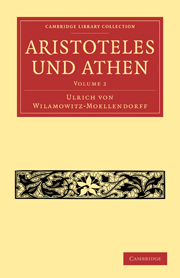Book contents
- Frontmatter
- Contents
- ZWEITES BUCH. Untersuchungen auf grund der aristotelischen Politie
- 1 Die quellen der griechischen geschichte
- 2 Die athenische politie von Kekrops bis Solon
- 3 Die athenische politie von Peisistratos bis Ephialtes
- 4 Πάτϱιoς πολιτεία
- 5 Die könige von Athen
- 6 Trittyen und Demen
- 7 Der athenische name
- 8 Der Areopag vor Ephialtes
- 9 3000 hopliten von Acharnai
- 10 Diobelie
- 11 Tιμήματα παρεχόμενοι
- 12 Λόγος und εὔϑυνα
- 13 Προχειροτovία
- DRITTES BUCH. Beilagen
- Sachregister
2 - Die athenische politie von Kekrops bis Solon
Published online by Cambridge University Press: 10 November 2010
- Frontmatter
- Contents
- ZWEITES BUCH. Untersuchungen auf grund der aristotelischen Politie
- 1 Die quellen der griechischen geschichte
- 2 Die athenische politie von Kekrops bis Solon
- 3 Die athenische politie von Peisistratos bis Ephialtes
- 4 Πάτϱιoς πολιτεία
- 5 Die könige von Athen
- 6 Trittyen und Demen
- 7 Der athenische name
- 8 Der Areopag vor Ephialtes
- 9 3000 hopliten von Acharnai
- 10 Diobelie
- 11 Tιμήματα παρεχόμενοι
- 12 Λόγος und εὔϑυνα
- 13 Προχειροτovία
- DRITTES BUCH. Beilagen
- Sachregister
Summary
Die steine der burg von Athen erzählen uns von einer zeit, deren selbst die sage vergessen hat. hinter der gewaltigen ringmauer wohnten die Kekroper in kleinen häuschen, und der palast ihres königs stand etwa da, wo die zeit Kleophons das Erechtheion gebaut hat. die burg hatte keineswegs nur den zugang von westen, sondern es führte von nordosten ein steiler aber breiter weg zum schlosse, und eine schmale treppe stieg zur späteren Pansgrotte hinab (Euripides nennt diesen weg μαϰϱαí) und weiter zur Klepsydra. am nordfusse des burgfelsens rann der fluss, an dem dieses Athen lag, der Eridanos, und sein ‘reines nass schöpften’ die mädchen. an der ecke, wo das Erechtheion mit dem Athenatempel zusammenstösst, den Peisistratos erbaut hat, zeigt die wand selbst, dass der baumeister auf einen raum darunter rücksicht nahm, das grab des Kekrops. kein zweifel, dass dieses grab die gebeine eines alten herren des schlosses barg oder birgt. noch heute kann der andächtige blick die male schauen, die der dreizack Poseidons in dem burgfelsen zurückgelassen hat, und ist auch Athenas ölbaum verschwunden, so ist doch die umfriedigung des gärtchens unverkennbar, in dem der tau der Agrauliden seiner wartete. auge und hand kann fühlung nehmen mit einer zeit, die eine verschollene urzeit war, als Peisistratos den alten tempel baute. damals spross noch der heilige ölbaum und stand noch der hausaltar der alten könige des schlosses. die continuität ist in Athen niemals abgerissen, obwol die erinnerung nichts fest gehalten hatte als die tatsache der continuität.
- Type
- Chapter
- Information
- Aristoteles und Athen , pp. 34 - 67Publisher: Cambridge University PressPrint publication year: 2010First published in: 1893

